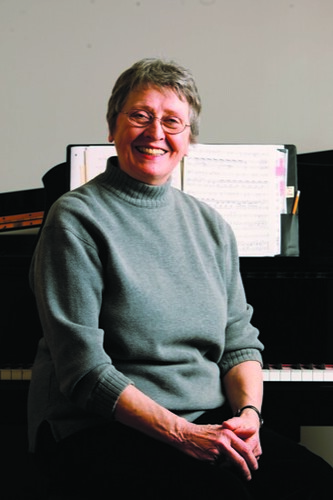
Photo by John Russell
To many musicians the piano accompanist is the equivalent of a second-string player, a backup to the real star. In fact, this couldn’t be further from the truth. Accompanying provides the definitive service to musicianship. It is an art form unto itself.
Daphne Nicar is among the cadre of accompanists who lend their talents to the Blair School of Music on a regular basis. For the past eight years, Nicar has been playing the piano primarily to accompany singers–soloists, choral groups and opera performers. Each of these genres requires a specific technique, Nicar says.
“When you’re doing an opera rehearsal, the job of the accompanist is not to follow the singer, but to follow the conductor–and that is harder for me, in a way,” she says. “In opera you have to change your focus. Your leader is the conductor.”
Professor Robin Fountain conducts many of Blair’s operas. His method is to work with Nicar and the singers during the first week of musical rehearsals and early staging. He then leaves while the cast continues to work on the music only. Once the singers have learned all the music, Fountain returns to begin the staging rehearsals. The accompanist’s challenge is to follow the conductor’s directions whether or not he’s in attendance.
Along with opera rehearsals, Nicar also plays the orchestral reductions (music originally written for other instruments and rescored for the piano) for students participating in concerto competitions. That, too, is its own animal. “You’re trying to imitate what an orchestra would do, to be the oboe, the strings or the horns. There’s a lot of tremolo and rumbling to make the piano sound like a full orchestra,” explains Nicar. “Playing orchestral reductions requires a completely different technique than playing music specifically composed for piano and singer. It’s not as physically pianistic, and it doesn’t necessarily fit the hand.”
Much of her work at Blair entails working with specific students on ensemble pieces in preparation for a recital. In those cases Nicar begins by sitting down with the singer and sight-reading the selected piece so they both share a feeling for its content and direction. After the singer has practiced on his or her own for a period of time, Nicar then begins discussing phrasing, tempo and breathing. An accompanist must give a singer time to breathe.
Nicar says, “From there we’ll work on the shape of phrasing and word emphasis. Then after we’ve finished rehearsing, I’ll tell them what consonants and vowels I couldn’t understand, where we need to work on tempo–how fast and how loud. We’ll discuss whether we’ve hit the mark stylistically. If it’s a romantic song, there will be a lot of give and take in the tempo.”
In other words, the accompanist is an active partner, not a sideline participant, in a musical performance. The skills of an accompanist are deemed so important that all Blair keyboard majors take classes in accompanying, during which they receive feedback and advice as they perform with an instrumentalist or vocalist.
Nicar says the beauty of accompaniment is that it is the consummate continuing education. “I wish more students wanted to do accompanying,” she admits. “From the time I left college, I learned more about musical ideas and interpretations from my experience accompanying other musicians and singers than I ever learned as a soloist.”